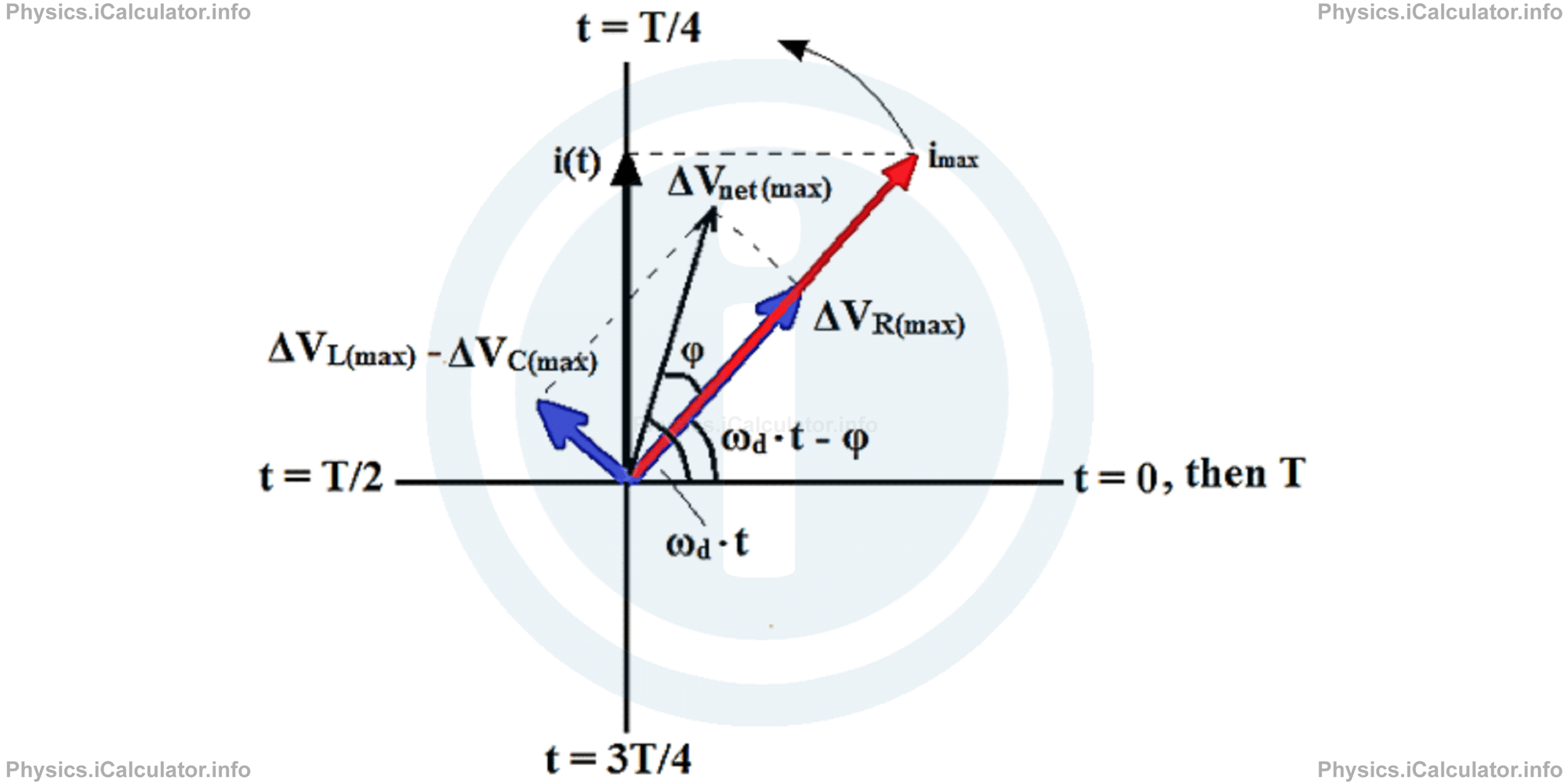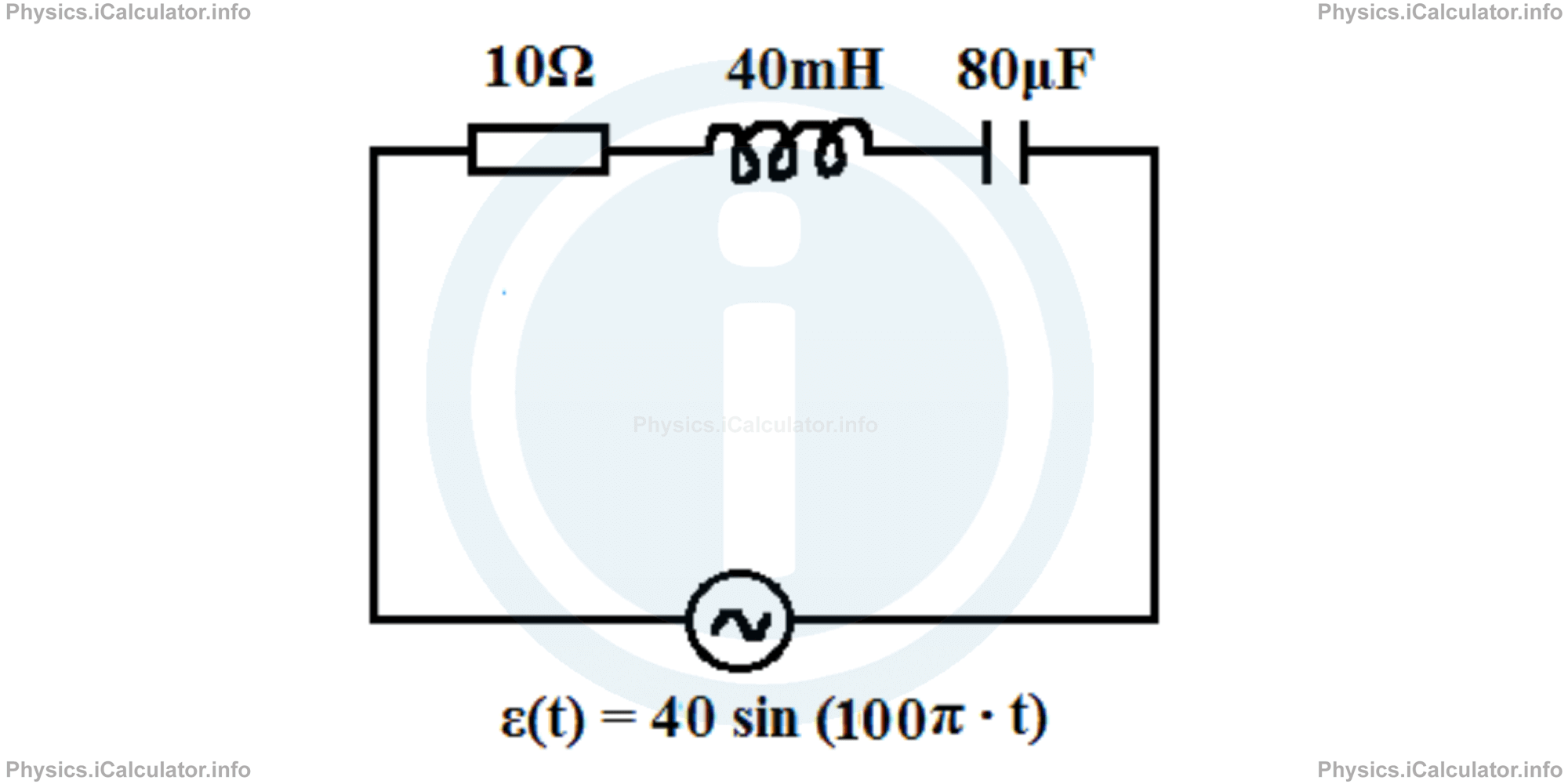Menu
Physics Lesson 16.16.3 - The Phase Constant
Please provide a rating, it takes seconds and helps us to keep this resource free for all to use
Welcome to our Physics lesson on The Phase Constant, this is the third lesson of our suite of physics lessons covering the topic of The Series RLC Circuit, you can find links to the other lessons within this tutorial and access additional physics learning resources below this lesson.
The Phase Constant
We have explained earlier that the only voltage in phase with current is the resistive voltage. This means for resistive voltage the phase constant is zero (φ = 0). As for the other two voltages, the phase constant is -π/2 for ΔVC and + π/2 for ΔVL.
However, we are more interested about the phase constant of the total voltage, than for individual voltages. In this regard, the general phase constant φ will be the angle formed by the resistive voltage and the total voltage phasors, as shown in the figure.

Applying the trigonometry rules, we have:
= ΔVL(max) - ΔVC(max)/ΔVR(max)
= imax ∙ XL-imax ∙ Xc/imax ∙ R
= XL-Xc/R
This formula obtained above is very important, as we don't have to know the amplitudes of current and potential difference in a RLC circuit to calculate the initial phase. It is enough knowing the values of resistance and the two reactances for this.
The following cases are present when considering the last equation of phase constant φ in a series RLC circuit:
- If XL > XC, the circuit is more inductive than capacitive. The phase constant φ is positive, so the phasor εmax is ahead of the current phasor imax.
- If XL < XC, the circuit is more capacitive than inductive. The phase constant φ is negative, so the phasor εmax is behind the current phasor imax.
- If XL < XC, we say the circuit is in resonance, for which we will discuss in the next paragraph. The phase constant is zero, so the current and voltage rotate together.
As special cases, in purely inductive circuits (XL ≠ 0 and XC = R = 0), we have the maximum value possible of phase constant (φ = π/2); in purely capacitive circuits (XC ≠ 0 and XL = R = 0), the phase constant is minimum (φ = π/2); while in purely resistive circuits (R ≠ 0 and XL = XC = 0) the phase constant is zero because φ = 0 and therefore, tan φ = 0.
Example 2
The equation of voltage in a series RLC circuit is
and the values of resistance, inductance and capacitance of the corresponding circuit elements (resistor, inductor and capacitor) are 10Ω, 40mH and 80μF respectively.
- What kind of circuit is it (more resistive, more inductive or in resonance)?
- What is the phase constant in radians and degrees?
- What is the maximum current in the circuit?
- What is the voltage in the circuit at t = 0.506 s after the switch turns on?

Solution 2
First, let's write some useful clues. Thus, from the equation of voltage, we see that
εmax = 40 V
ωd = 2π ∙ f = 100π rad/s = > f = 50 Hz
R = 10 Ω
L = 40 mH = 4 × 10-2 H
C = 80 μF = 8 × 10-5 F
- To know what kind of circuit is it, we have to find the two reactances. Thus, XL = ωd ∙ Land
= (100π rad/s) ∙ (4 × 10-2 H)
= 4π Ω
= 12.56ΩXc = 1/ωd ∙ CThus, since XC > XL and R ≠ 0, the circuit is more capacitive than inductive.
= 1/(100π rad/s) ∙ (8 × 10-5 F)
= 39.81 Ω - The phase constant is calculated by tanφ = XL-Xc/RTherefore, the phase constant φ is
= 12.56 Ω - 39.81 Ω/10 Ω
= -2.725φ = tan-1 (-2.725)The negative sign means the phasor εmax is behind the current phasor imax by 69.80.
= -1.219 rad
= -69.80 - The maximum current in the circuits is imax = εmax/Z
= εmax/√R2 + (XL-Xc )2
= 40 V/√(10 Ω)2 + (12.56 Ω-39.81 Ω)2
= 40 V/29 Ω
= 1.38 A - The voltage in the circuit at t = 0.506 s is ΔV(t) = ε(t) = 40 ∙ sin (100π ∙ t)Thus,ΔV(0.506) = 40 ∙ sin (100π ∙ 0.506)
= 40 ∙ sin (50.6π)
= 40 ∙ sin (0.6π)
= 40V ∙ 0.951
= 38.04 V
You have reached the end of Physics lesson 16.16.3 The Phase Constant. There are 5 lessons in this physics tutorial covering The Series RLC Circuit, you can access all the lessons from this tutorial below.
More The Series RLC Circuit Lessons and Learning Resources
Whats next?
Enjoy the "The Phase Constant" physics lesson? People who liked the "The Series RLC Circuit lesson found the following resources useful:
- Phase Constant Feedback. Helps other - Leave a rating for this phase constant (see below)
- Magnetism Physics tutorial: The Series RLC Circuit. Read the The Series RLC Circuit physics tutorial and build your physics knowledge of Magnetism
- Magnetism Revision Notes: The Series RLC Circuit. Print the notes so you can revise the key points covered in the physics tutorial for The Series RLC Circuit
- Magnetism Practice Questions: The Series RLC Circuit. Test and improve your knowledge of The Series RLC Circuit with example questins and answers
- Check your calculations for Magnetism questions with our excellent Magnetism calculators which contain full equations and calculations clearly displayed line by line. See the Magnetism Calculators by iCalculator™ below.
- Continuing learning magnetism - read our next physics tutorial: Power in an Alternating Circuit. Transformers
Help others Learning Physics just like you
Please provide a rating, it takes seconds and helps us to keep this resource free for all to use
We hope you found this Physics lesson "The Series RLC Circuit" useful. If you did it would be great if you could spare the time to rate this physics lesson (simply click on the number of stars that match your assessment of this physics learning aide) and/or share on social media, this helps us identify popular tutorials and calculators and expand our free learning resources to support our users around the world have free access to expand their knowledge of physics and other disciplines.
Magnetism Calculators by iCalculator™
- Angular Frequency Of Oscillations In Rlc Circuit Calculator
- Calculating Magnetic Field Using The Amperes Law
- Capacitive Reactance Calculator
- Current In A Rl Circuit Calculator
- Displacement Current Calculator
- Electric Charge Stored In The Capacitor Of A Rlc Circuit In Damped Oscillations Calculator
- Electric Power In A Ac Circuit Calculator
- Energy Decay As A Function Of Time In Damped Oscillations Calculator
- Energy Density Of Magnetic Field Calculator
- Energy In A Lc Circuit Calculator
- Faradays Law Calculator
- Frequency Of Oscillations In A Lc Circuit Calculator
- Impedance Calculator
- Induced Emf As A Motional Emf Calculator
- Inductive Reactance Calculator
- Lorentz Force Calculator
- Magnetic Dipole Moment Calculator
- Magnetic Field At Centre Of A Current Carrying Loop Calculator
- Magnetic Field In Terms Of Electric Field Change Calculator
- Magnetic Field Inside A Long Stretched Current Carrying Wire Calculator
- Magnetic Field Inside A Solenoid Calculator
- Magnetic Field Inside A Toroid Calculator
- Magnetic Field Produced Around A Long Current Carrying Wire
- Magnetic Flux Calculator
- Magnetic Force Acting On A Moving Charge Inside A Uniform Magnetic Field Calculator
- Magnetic Force Between Two Parallel Current Carrying Wires Calculator
- Magnetic Potential Energy Stored In An Inductor Calculator
- Output Current In A Transformer Calculator
- Phase Constant In A Rlc Circuit Calculator
- Power Factor In A Rlc Circuit Calculator
- Power Induced On A Metal Bar Moving Inside A Magnetic Field Due To An Applied Force Calculator
- Radius Of Trajectory And Period Of A Charge Moving Inside A Uniform Magnetic Field Calculator
- Self Induced Emf Calculator
- Self Inductance Calculator
- Torque Produced By A Rectangular Coil Inside A Uniform Magnetic Field Calculator
- Work Done On A Magnetic Dipole Calculator